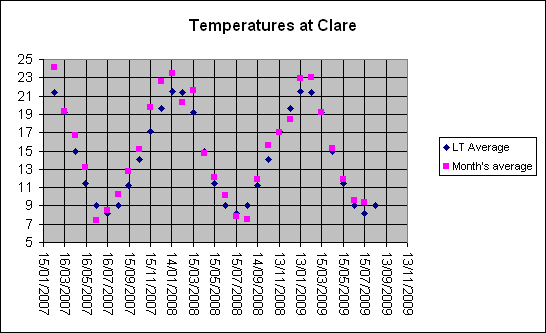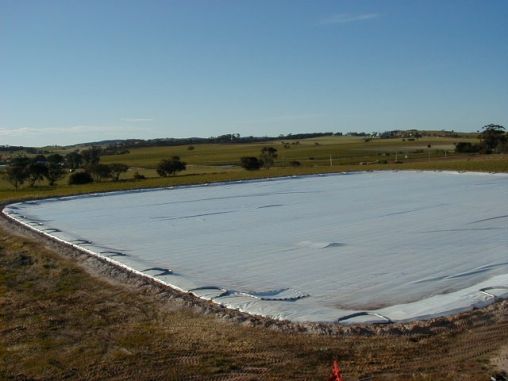|
|
Reducing evaporation losses from farm dams
Rainfalls in southern Australia are declining and at the same time
evaporation rates are increasing due to the warming climate.
So while the quantity of water that is getting into dams, reservoirs and
rivers is decreasing, the evaporation losses from those storages are
increasing and the water demand of irrigated plants is also increasing.
The result is that water is becoming steadily harder to get and more precious.
I was loosing too much water from my dams
and decided that I had to do something about it.
This page was written partly to inform others of what's out there and
the pros and cons of each option, and partly for my own information.
I'd love to have notes from people who have dealt with this problem or
are seriously considering any out-of-the-ordinary fix.
Written 2009/03/12, modified 2009/09/23
Contact: email daveclarkecb@yahoo.com
|
|
|
 This is a work in progress
This is a work in progress |
|
|
In effect, the
cost of water in southern Australia
has increased significantly in the last decade or two.
Our governments should be spending serious money on researching evaporation
limiting methods, but do not appear to be doing so, just as they are doing
next to nothing to limit the cause of the problem –
climate
change.
What can be done economically to reduce the evaporation losses of the
increasingly precious and scarce water in storages across southern Australia?
Whatever is done will cost money, but often to get by without water is not
an option, we simply must have the water!
In my own dams I loose far more water to evaporation than I use for
irrigation,
I think that this would apply to most of the dams in the Clare valley,
especially the smaller ones.
Annual evaporation in the region is around two metres.
In warmer areas – and most of South Australia is warmer than Clare
– the losses would be even worse.
The simple loss of water is not even the whole problem; when the water
evaporates any salt – there is always salt in natural water –
is left behind; so the salinity of the remaining water increases.
The higher the salinity of water, the more problematic is its use.
- How stable will the cover/barrier be in high winds?
- Will it be stable when the dam is dry?
- Are there special requirements – at least one product requires
30cm or more of water in the dam at all times?
- Will it leach toxic substances into the water?
- How will it stand up to what is a corrosive environment – continual
contact with water and air and some level of salinity; exposure to
ultra-violet light that can degrade some plastics?
- Some products are easily and cheaply installed by the land owner,
others require expensive installation by specialists.
- What warrantee is there and is the company likely to be around in five
years if you need to call on the warrantee?
- Does the product need to cover only the water, or does it need to be large
enough to allow for anchoring beyond the lip of your dam – making a big
impact on the final price?
- If your dam wall is vegetated, how much damage will be done to this during
installation?
|
|
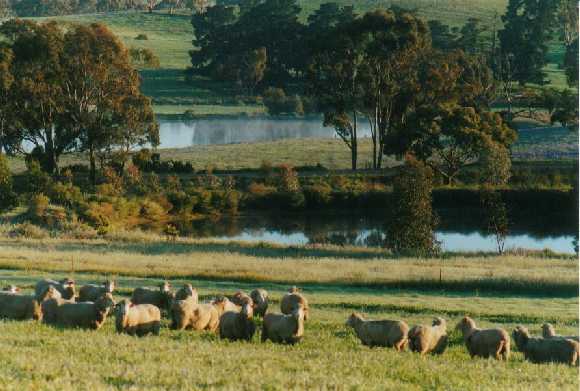
|
Full dams, a sight we don't see so often in recent years.
(My dam, the nearer one, filled about two years out of every three in its
first ten years, in the six years since then it has not filled at all.)
Note that the wall of my dam is vegetated.
Installation of some evaporation barriers would involve heavy damage to this.
The capacity of my dam is about 2.5ML.
|
|
Consideration should also be given to what will happen to dust and leaves
that will blow onto the devices; what happens to the rain that falls onto
them?
Some systems require pumping to remove rain water from the cover;
increasing costs and labour.
Several of the products use expanded polystyrene which, in my experienc,
becomes chalky and powdery on the surface after long exposure to sunlight.
Obviously if your dam leaks then an evaporation barrier is not going to
change that.
All of the products that seem likely to be acceptable and effective are
going to stop you from swimming in your dam.
My reading on the evaporation barrier subject indicates that if the
water contains a significant amount of organic matter (leaves, algae,
invertebrates, etc.) there must be significant contact between air and
water to avoid the water going bad.
If contact with the air and light is cut off the algae and inverbebrates
will die.
They and the leaf litter will then rot and this will quickly use up all
the oxigen in the water; substances such as
methane and hydrogen sulphide (rotten egg gas) are produced by bacteria
that live in anoxic conditions, and quite
probably the water will become acidic.
This problem can be avoided if most of the organic matter is removed from
the water before it goes into the sealed storage.
Evaporation reduction does not come cheap; either you pay for ready-made
fixes in money or you pay for home-made fixes with less money but a lot
of your time.
The costs of the individual products can be found in
another section of this page.
A rough calculation: my case –
Average annual evaporation in my area (Clare, SA) is about 2m.
In my dam
this represents something like a megalitre of water (it depends
very much on how much water is in the dam at the start of the evaporation
season).
If the cure I use reduces the evaporation by 80%, costs $7000 and lasts
twelve years this is 800kL × 12 = 9.6ML;
$7000 for 9.6ML is $0.73/kL.
This might be compared with using a big covered tank.
I priced a 250kL tank at $15 000.
Assuming a life of 15 years we have
250kL × 15 = 3.75ML; $15 000 for 3.75ML
is $4/kL.
Also the evaporation barrier will make up to 2ML available to me while
the tank would only have given me an eighth as much.
I will leave it to the accountants to calculate money costs, depreciation,
etc.
|
|
My dam
is in the Clare Valley of South Australia.
The climate is changing in the Valley; rainfalls are decreasing and
temperatures are increasing; consequently runoff is decreasing and
evaporation (and evaptranspiration) is increasing.
This would apply to most of the southern half of Australia.
|
Clare rainfall
|
|
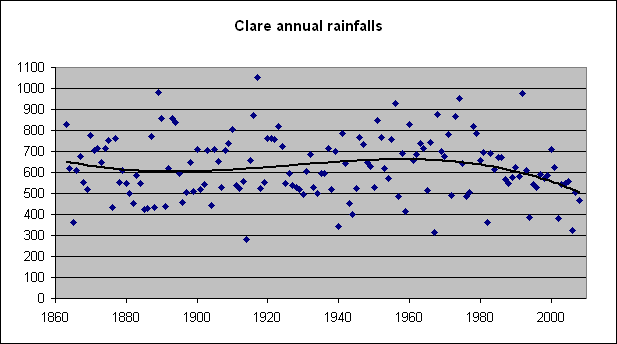
| |
Note the decline in rainfall in recent years
|
|
The graph at the right is made up of Bureau of Meteorology data taken from
Clare Post office (1863 to 1994) and Clare High School (from 1995 onward).
The average annual rainfall from 1863 to 1990 was 632mm, from 1991 to
2008 it was 557mm, 75mm lower.
In the period from 1994 to 2008 the average was 525mm, 107mm lower than
the 1863 to 1990 average.
The curved line was calculated as a line of best fit to the data.
The steepness and persistence of the decline in rainfalls since about 1970
seems to be unprecedented in the data.
Plainly the declining rainfalls, combined with higher temperatures,
will stress perennial plants.
Worryingly, the decline in rainfall seems to be becoming steeper, there
is no reason to think that the bottom has been reached.
Clare temperatures
In the graph at the right the
blue diamonds are long-term average monthly temperatures for Clare.
Pink squares are averages of the temperatures measured in particular months.
Note that in most cases the temperatures (and in particular those of the
spring and summer of 2007/08) were higher than those for average months
(pink plots are above blue plots) –
evidence that the climate is warming in the Clare Valley.
On average the temperatures during the whole of the period shown on the
graph were 0.79° warmer than the long-term average.
These data are extracted from Bureau of Meteorology records available on
the Net.
The products
Below I have listed the evaporation reduction methods that I have found
and included comments that I believe to be relevant to evaluating them.
It seems that a number that have been promoted are not now available
(September 2009).
In the case of Aquatain, I have included details of tests that I did on
its efficacy.
For the solid barriers and covers I have excluded at least some products that
were more expensive than about $15 per square metre: I can't afford to pay
that much (except if I was sure that such a product would last, say, twenty
years or more, and none of these products have been available for anything
like that length of time).
The products are listed in alphabetical order.
|
|
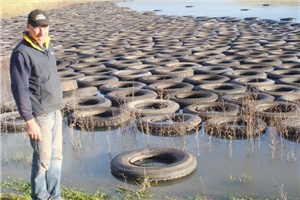
|
Agfloat recycled tyres on a community dam at Blyth, SA
Photo credit Northern Argus
|
|
A system that uses recycled tyres as an evaporation barrier,
with polystyrene to make the tyres
float, has been commercialised in South Australia under the name Agfloat.
(An earlier version of Agfloat used recycled polystyrene, but a newer
process [September 2009] uses new; with the hope of being able to use half
recycled and half new at some time in the future.)
The business is based at 93 Frome St., Adelaide (phone
08 8232 3388),
and has another site at 20 Evans St., Woodside,
(SA, phone 08 8389 9544)
The person to talk to is John Crosby.
To my knowledge, the system has been used on at least one station
(NW of Kimba in South Australia).
The manager of that station told me that it had resulted in an 80% reduction
in evaporation.
As I write in July 2009, Agfloat are converting from a system based on
truck tyres to one based on car tyres.
The latter have the advantage to the land-holder of being lighter and
easier to move, if that is necessary; Mr Crosby claims that the new
system will provide even greater evaporation reduction.
Cost
As of July 2009, I believe the price of these has not been decided, because
of the conversion in the process, but I am lead to believe that they should
cost about $10 per square metre; about $7000 for my approximately
700m2 dam.
My thoughts
This product seems to me to be the front runner.
Its price is much lower than Aquacap and I like the
fact that it is using recycled tyres that would otherwise go to land fill.
The tyres should protect the polystyrene from degradation by ultraviolet
light.
I should check that there is negligible leaching of toxic substances
into the water (vulcanised rubber,
as in tyres, contain significant sulphur).
|
|
A quick Net search suggested to me that this product may still be available
for swimming pool covers, but not for dam covers.
|
|
|
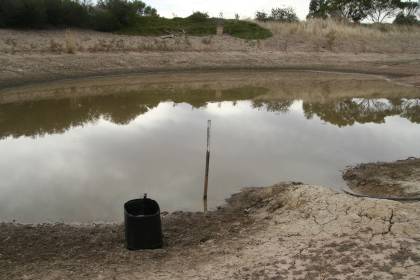
| First evap. gauge setup
Dam and tub
| |
| 
| | First evap. gauge setup.
Tub with its gauge, gauge in dam (there is a wooden ruler nailed to the
stake)
| |
| 
| | Second evap. gauge setup.
Tub buried to reduce solar heating; the clamp holds a ruler marked in
millimetres
| |
| 
| Second evap. gauge setup
Tub and dam
| |
| 
| Second evap. gauge setup
Gauge in dam
| |
Aquatain is a silicone based liquid that is spread in a very thin layer on
top of bodies of water to form a barrier stopping contact between water and
air and reducing the amount of loss to evaporation.
The maker, Guyco, claims Aquatain will reduce evaporation by more than 50%.
An Internet search that I conducted didn't show any independent research
that had been done on the effectiveness of Aquatain.
Aquatain has a site on the
Net.
I emailed Aquatain (info@aquatain.com.au) on 2009/03/02 inquiring about
whether any independent report of the product's effectiveness was available.
I received a reply from Peter Leach, (a/the) director of Aquatain
the following day.
Total Ag Services Pty, Ltd of Dalby, Qld. had done an evaluation in April
2007.
Peter Leach forwarded me a copy of this.
The trial was carried out over a three-week period and the gist of the
report was that the evaporation was reduced by about 50% during this period.
Mr Leach also forwarded a water test report which suggested that the water
quality was not adversely effected by Aquatain.
As I had bought 2½L of Aquatain I decided to do my own testing.
My trial involves comparing the changes in water level in a dam (treated
with Aquatain) with the changes in water level in a 20L drum, open at the
top.
My trial setup was very simple.
Note that seepage could affect the results of this trial, see
note below.
| Aquatain trial record
|
|---|
| 2009/02/28 | First evap. gauge setup
|
|---|
| Date | Dam loss
(mm) | Tub loss
(mm) | Saving
(mm)
| Saving
(%) | Notes
|
|---|
| 2009/02/28 | - | - | - | - | Aquatain added
|
| 2009/03/06 | - | - | - | - | Water level gauges installed
|
| 2009/03/07 | 7 | 6 | -1
| -17% | -
|
| 2009/03/08 | - | - | - | - | More Aquatain added
|
| 2009/03/10 | 12 | 19
| 7 | 37% | -
|
| 2009/03/12 | 12 | 12
| 0 | 0% | -
|
| Total, 1st trial | 31 | 37
| 6 | 16% | End first trial
|
| 2009/03/12 | Second evap. gauge setup
|
|---|
| Date | Dam loss
(mm) | Tub loss
(mm) | Saving
(mm)
| Saving
(%) | Notes
|
|---|
| 2009/03/15 | 21 | 19
| -2 | -11% | More Aquatain added
|
| 2009/03/24 | 49 | 41
| -8 | -20% | More Aquatain added
|
| 2009/03/29 | 10 | 15
| 5 | 33% |
|
| 2009/04/02 | 27 | 27
| 0 | 0% |
|
| Total, 2nd trial | 114 | 109
| -5 | -5% | Second trial
|
| Total | 145 | 146
| 1 | 1% | First and second trial
|
A flaw in my first trial setup was that the tub would be likely to get
quite hot in the sun and then the amount of evaporation from it would
increase due to this heating.
By setting the tub in the ground this disproportionate solar heating should
be avoided.
Conclusion
My trial indicated that Aquatain, at least in this particular setting,
is of no value.
There is a suggestion in the data that the layer disappears after only a
day or two.
Could it be that Aquatain is adsorbed onto the clay particles around the
edge of my dam?
Clay very effectively adsorbs many substances.
Perhaps Aquatain would work where it does not come into contact
with clay, for example, in the case of a plastic-lined dam?
Aquatain has been on the market for several years, it is readily available;
it was held in stock at my local irrigation supply store.
Many people must have tried it.
It is disappointing that no-one else had taken the little trouble needed
to investigate whether the stuff worked and put their results on the Net.
The above calculations do not take into account the possibility of seepage.
Measurements that I did in June and July of 2009 indicated that seepage in
my dam is negligible.
|
|

| Aquacap
Image from Nylex
| |
This product is by Nylex/Rio Tinto who have a Net page on the product at
http://www.aquacap.com.au.
It is claimed that Aquacap reduces evaporation by 85%.
The product is a circular floating disc made of polypropylene, 1.15m in
diameter, 200mm high and weighing 3kg each.
They are claimed to have been tested to wind speeds of 130kph.
Lifespan is claimed to be five years plus.
Other benefits claimed:
- UV and wind proof;
- Allows rain water to enter the storage facility;
- Preserves water quality;
- Easy to transport;
- Wind, hail and debris resistant.
Telephone 0438 309 530
Cost
I phoned and asked for an approximate price for my dam,
which is about 700m2 in area.
I was told I'd need about 600 discs at a price of $23.50 each plus GST,
a total of about $15 500 ($26 per square metre); much more expensive
than Agfloat.
|
Mentioned in the
DKCRC, WaterSmart paper,
apparently not commercially available yet.
No URL or supplier details known.
|
|
|
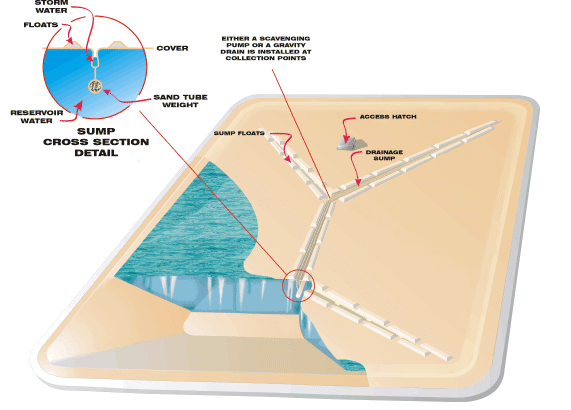
| |
Defined Sump dam cover system: Image from Layfield
|
|
Made by Layfield/C. W. Neal, this and
Revoc have a
page on the Net.
Layfield's blurb:
"Defined sump floating reservoir covers use a combination of attached closed
cell foam floats and sand tube ballasts.
These elements are used to create drainage sumps that collect and carry
storm water to either scavenging pumps or gravity drains for water removal
into a drainage system.
The floating cover itself is typically fabricated of reinforced Hypalon or
polypropylene geomembranes.
Floats and ballasts are encapsulated in geomembrane as well for maximum
longevity.
Our new lightweight evaporation control covers and algae control covers are
produced from unsupported Enviro Liner 6030.
Enviro Liner 6030 is a highly durable cover material which offers excellent
long term weathering capabilities and is NSF 61 certified for potable water
applications."
My thoughts
I suspect that installation would cause serious damage of the native
vegetation on my dam wall.
The Desert Knowledge CRC paper
gives an estimated cost (Dec. 2004) of $30/2m, which is too
expensive for me.
I have no need to keep water and run-off out of
my dam – quite the contrary.
|
|
The Net page is not very
informative.
It states several times that the product is a "Twin Plastic Board cover",
but does not state what the plastic is, nor any detail about construction.
It goes on to state; "Maintaining healthy water quality:
Our solution hampers bacterial growth by allowing natural UV light to filter
through and kill bacteria.
This helps maintain the water in a good condition."
This sounds highly questionable to me; bacteria are a very natural part of
any ecosystem, and while they are killed by ultra violet light, this would
only happen in the upper levels of any murky dam.
The Net page states that the cover is guaranteed for three years against
damage by UV light.
This seems to me to be inadequate; what about damage from wind and other
causes (such as animal feet)?
In any case a dam cover should have a life much greater than three years.
Cost
The Net page states that the cost is $8 per square metre, and installation
is done by the land-owner.
The product comes in 3mm or 5mm thickness "depending on the desired
application and strength"; presumably the $8 price applies to the 3mm
thickness.
Contact
New Fast Link Pty Ltd
Trading as Dam Covers Now
31 Cheam St, Dandenong North, VIC 3175
Ph: +61 3 9774 8303 | Fax: +61 3 9774 7336 | info@afb.com.au
|
E-Vap Cap is a floating polyethylene sheet cover; there is a
Net page.
The Net page states:
"The floating cover consists of a unique, multi-layered, polyethylene
membrane 540 microns in thickness that contains its own buoyancy cells.
It carries a 5-year pro-rata warranty against UV breakdown due to sunlight
exposure (independent NATA laboratory testing indicates a much longer
"life" expectancy than 10 years). Optional thicker material, up to 1000
microns is available giving greater warranty and a design life of 20 years."
An inquiry requesting price and installation requirements, 2009/08/18,
resulted in a quick response including a pdf file on E-vapcap and other
products by the same company.
This pdf file stated, among other things,
that "The covers feature a conditional ten year warranty,
however, testing indicates a much greater lifespan"; which is true, five
or ten year?
A request for a price resulted in a written quote from Bartlett Water
Services.
I had given 20m x 30m as the approximate dimensions of the surface of the
water in my dam when full.
Bartlett took my dimensions to be those of the dam at the top of the
batters, which would actually be considerably larger than my 20x30m.
They stated that the "quantity of material required including allowances
for top of banks, anchor trenches, welding overlaps etc is approx.
1011.842" and gave an approximate price of $10 175 plus
freight.
As the dimensions of my dam at the top of the batters would probably be
at least 25x35m it would seem the adjusted cost would be considerably higher,
perhaps $14 000, plus freight ($23 per square metre in my case).
Installation was not included in the quote.
None of the information I have read on E-Vap Cap says anything about whether
any significant contact between the air and the water in the dam is
maintained.
My general reading indicates that
such contact is
important.
My thoughts
This product is expensive, especially so as it must be large enough to not
only cover the water in the dam but also the anchoring trenches.
my dam
wall is well covered in native vegetation that has become established
over a period of 15 years; digging the anchor trenches and refilling them
would destroy much of this.
My reading on the evaporation barrier subject indicates that there must be
significant contact between air and water if there is to be no risk of
the water becoming anoxic, smelly, and deadly to most aquatic organisms.
Would this cover provide that contact?
What happens to dust, leaves, etc. that blow onto the cover, and rainwater
that falls on the cover?
How stable would the cover be in strong winds, especially when the water
level in the dam is low?
|
Quoting from
DKCRC, WaterSmart paper:
- Description:
- The cover is comprised of laminated 20 micron, stainless steel mesh
and 0.4mm bubble HDPE sheet.
The cover is anchored to the storage
floor by cables attached to a buried polyethylene pipe.
It is designed to only cover 90% of the water surface area.
- Manufacturer/Supplier:
- Reservoir Covers Australia (Pty Ltd proposed extension).
- Performance as stated by the manufacturer:
- May reduce evaporation by up to 90 per cent depending on the water
level of the storage.
- Costs:
- $3.50/m2 for complete installation.
- Durability:
- Life expectancy of 30 or more years – resistant to UV light and
oxidation.
- Installation:
- Not available.
- Advantages:
- It is simple and easy to install, heat reflective and self-protecting in
high winds (up to 150 kph) whether empty or full. The cover is also
suitable for all storage sizes, shapes and profiles up to 2 km wide.
|
Apparently Evap-Mat is a product of DeVere Mining Technology Limited,
who state on their
Evap-Mat Net page that it is "a low cost, long life floating cover for
water reservoirs and dams at mining sites".
DeVere also state that the project is temporarily on hold (2009/09/17).
My thoughts
The expected life is great, but why then is no warrantee period stated?
|
|
|

| |
Fabtech dam cover: Image from
Fabtech
|
|
Fabtech have a page on the
Net.
They claim to have 25 years experience in liquid containment.
I did not find their Net page very informative.
I sent an email to admin@fabtech.com.au seeking more information regarding
a cover for my dam (2009/09/17).
Quoting from
DKCRC, WaterSmart paper:
- Description:
- An independent modular system made from UV resistant recycled
plastic – each module covers one square metre.
- Manufacturer/Supplier:
-
Indusium Pty Ltd and tested by the Queensland University of
Technology. Stoph Vanwensveen
- Email:
- stvn@bigpond.com (apparently no longer valid: DC)
- Performance as stated by the manufacturer:
- Reduce evaporation by up to 90%
- Costs:
- The anticipated cost is $4.50-8.00/m2
- Durability:
- Expected life of more than 25 years.
- Installation:
- This cover may be easily installed by the owner.
- Advantages:
- It has been shown to greatly reduce the effects of wave action, and is
easily installed by the customer.
|
I was unable to find anything on the Net connected with this product
(2009/09/17).
My thoughts
If it is easily installed by the owner then there must be no need for
earth-works to anchor it.
I like the fact that it uses recycled plastic.
No warrantee is mentioned.
|
|
|
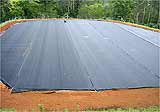
|

| |
Netpro dam cover: Images from Netpro's Net page
|
|
Netpro
produce a suspended dam cover.
Knitted shadecloth is supported by poles and high-tension steel cable.
The support structure lifespan is claimed to be 30 years, and the canopy is
expected to last more than 15 years.
My thoughts
The anchoring of the high tension steel cables would require major
disturbance of the native vegetation on my dam wall.
|
Mentioned in the
DKCRC, WaterSmart paper,
apparently not commercially available yet.
My thoughts
Polynet is based on polystyrene sheets wrapped in a net.
Polystyrene becomes chalky and powdery when exposed to sunlight for long
periods.
|
Quoting from
DKCRC, WaterSmart paper:
- Description:
- Quit Evap is a rectangular modular floating cover, manufactured from
0.5-0.75 mm thick polypropylene sheet with polystyrene floats.
The modules are interconnected by Velcro straps. The full scale modules
are up to 5 m x 25-30 m.
- Manufacturer/Supplier:
- SMEC Australia Pty Ltd. (Contact: Peter Chapman)
Address: 1st floor, 105 Denham Street Townsville Qld 4810
Phone: (07) 4771 6119
Fax: (07) 4771 6120
Email: Peter.Chapman@smec.com.au
- Performance as stated by the manufacturer:
- Can effectively achieve 90-95 per cent coverage of the water surface
and reduce evaporation by 85-90 per cent.
- Costs:
- The estimated cost is around $6.00-8.00/m2 plus transport and
installation.
- Durability:
- The cover has a minimum life span of 5 years with a potential life of
8-10 years – the cover is also UV stabilised.
- Installation:
- Installation of this product is easy and may be done by the owner.
- Advantages:
- Lightweight and easy to install.
|
My thoughts
A life span of five, even eight, years is not long enough.
|

|
A Raftex cover on a dam
Image from Raftex
|
|
Raftex is a product of F Cubed Australia Pty. Ltd., 23 Millennium Park
Drive, Whittlesea, Victoria, Australia, 3757.
They can be reached at email fcubed@fcubed.com.au
It is claimed that "Raftex has been comprehensively tested by the
University of Southern Queensland for the National Centre for Engineering
in Agriculture.
The Raftex units are hexagonal and link together – with sufficient
space between units to allow proper aeration of the water and for rainwater
to get into the pondage.
Each panel weighs 16kg, covers 16m2 of water and is made of
galvabond steel tubing, polystyrene foam, and polyethylene film.
It has a 10 year guarentee.
Apparently a minimum of 30cm of water should be left in the dam at all
times to anchor the panels.
My thoughts
The requirement for a minimum of 30cm of water in the dam is a concern;
how could one make sure that there is always at least that much water left
in the dam – after all, lack of water is the problem that these
devices are supposed to solve.
And in a small dam that may only be two or three metres deep, 30cm
represents a considerable volume of water.
What life would the galvanised steel have in a continually damp situation,
especially if significant salinity was involved?
A guarentee is not much use if the company behind the product goes broke.
|
|
|
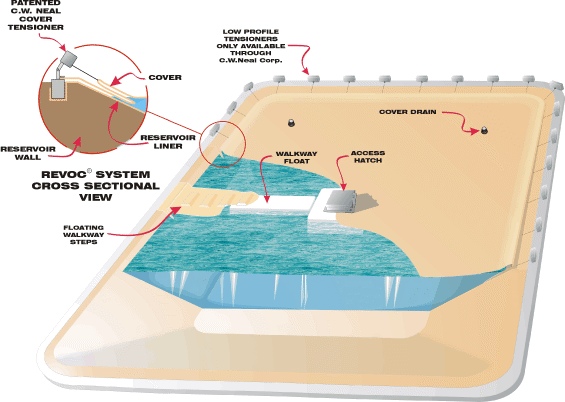
| |
Revoc dam cover system: Image from Layfield
|
|
Made by Layfield/C. W. Neal, this and
Defined Sump have a
page on the Net.
Layfield's blurb:
"REVOC Floating covers use patented tensioners attached around the perimeter
of the cover system to prevent undue cover movement and wrinkling
regardless of the reservoir's water level fluctuation.
Tensioners also serve to retain slack cover material in a defined peripheral
sump.
Cover drains conduct storm water into a drainage system.
The floating cover is typically fabricated of reinforced Hypalon or
polypropylene geomembranes.
Floats and weights are encapsulated in geomembrane for maximum longevity.
REVOC floating covers offer lower maintenance and lower replacement cost
than other floating cover type."
My thoughts
Installation of the tensioners would cause serious damage of the native
vegetation on my dam wall.
The Desert Knowledge CRC paper
gives an estimated cost (Dec. 2004) of $30/2m to Layfield's
other dam cover,
Defined Sump, which is too
expensive for me.
I have no need to keep water and run-off out of my dam – quite the
contrary.
|
This is a powder that is spread over the surface of the water.
It is claimed that evaporation is reduced by "up to 50%".
I believe that it needs to be replaced at fairly frequent intervals.
Flexible Solutions have a
Net page on WaterSavr.
My thoughts
I know very little about the product, but the idea of a powder on the
surface of the water in my dam does not appeal.
How stable would it be in strong winds?
Will it mix with the mud and leaf litter that is in the dam?
Why does it need to be topped-up, does it degrade?
If so, what does it leave behind?
Will it harm the water quality or damage the soil?
How would I dispose of it if it didn't do the job?
|
|
There are more products out there for reducing evaporation.
I'd be grateful if any reader can tell me anything useful about other system,
or those mentioned above,
especially if they have had personal experience with them; my
email address is at the top of this page.
|
|
I considered making a shade cloth cover for my dam.
It would shade the water and greatly reduce wind velocity over the water;
both factors reducing the evaporation rate.
I decided against the idea, having used shade cloth in areas exposed to
wind I knew that is could suffer from wear if it was to move at all over any
supporting structure, and I decided that the support it would need would
be complex and expensive.
The cost of the shade cloth itself would also be quite high.
|
|
Selected flotsom picked up from beaches could be useable.
Scrap plastic bottles are available in big numbers, but I suspect they
would have a short life if exposed to sunlight; if the bottles themselves
didn't deteriorate, the caps might.
Also they could blow off the dam's surface, unless they were partly filled
with water.
South Australia's container deposit would pose an administrative problem
here.
Wine bottles are available in large numbers at no cost from at least some
recycling agents.
Unfortunately a very large number of wine bottles (about 60/m2,
around 42 000 for my dam) and some very cheap way of sealing them
would be needed.
The time required for collecting and sealing the bottles would make the
project impractical.
Glass objects can be produced cheaply and glass has a very long life in
the open and would not cause any pollution of the water in the dam.
Could purpose-made glass floats be made at a competative price?
Installing the glass floats without smashing them would pose a technical
problem.
Glass floats (old bottles?) incorporated into recycled plastic sheets could
well be both practical and cheap.
The problem of the fragility of glass would be solved because the bottles
would be protected by a coating of plastic and the plastic could seal the
bottles.
The bottles would provide the buoyancy needed to keep the recycled plastic
above the water.
|
|

| |
Tyre floated using six bottles
|
|
Also see Agfloat.
Perhaps glass (or plastic) bottles could be used to create the necessary
buoyancy to float the tyres?
The tyre on the right is buoyed by six corked wine bottles, it is 62cm in
diameter, 0.30m2 in area.
The bottles fit snuggly into the tyre and would be very unlikely to come out.
Given approximately three tyres per square metre my dam would require
about 2100 tyres buoyed by 12 600 bottles; still a very large number
of bottles.
I used used wine bottle corks for the tyre in the photo.
An important unknown is the effective life of the corks.
Old tractor tyres are freely available in agricultural areas where there
are also many dams.
Used 20L pesticide containers are also plentiful.
Cleaned 20L containers can be used to make floats (four to a tyre) inside
the tractor tyres; the tyres would protect the containers from most sunlight.
Why not float scrap wood on the dam's surface?
Untreated wood will, I believe, become waterlogged, sink, and rot; not only
becoming useless, but polluting the water.
I wouldn't use wood treated with copper, chrome arsenate (CCA, the green
stuff) because of the risk of the heavy metals leaching into and poisoning
the water.
What about wood treated with creosote?
The creosote would stop the wood from rotting and might stop it from
becoming waterlogged.
It would be unadvisable to use water from any dam with creo scrap floating
on it for drinking or for water for animals to drink, but it might be
harmless for irrigation of plants?
I'm thinking something like creo posts pulled out of old vineyards;
the creosote would be much more bound to the wood in such old posts than
in new ones.
It would be possible for scrap wood to be coated with something to
waterproof it, but this doesn't seem to be something the dam owner could
practically do.
Could wood be protected from waterlogging by encasing it in recycled plastic?
It might be a business opportunity.
|
A 7MB pdf file on "Loss of storage water through evaporation with
particular reference to arid and semi-arid zone pastoralism in Australia"
is available from
Desert Knowledge CRC (CRC – cooperative research centre).
This document includes a description of the problem and summarizes types of
solutions that have been used, it includes an extensive list of available
products, provides a valuable summary of each and is
a good starting point for researching the barrier that is right for you.
However it does not provide any independent evaluation of products and some
of the prices quoted seem at odds with prices I have obtained.
Other links are within the sections on various products.
|
 This is a work in progress
This is a work in progress

